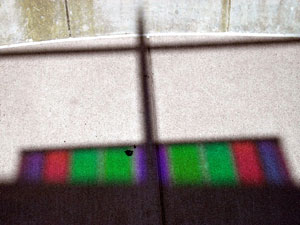It's approaching that time of year again: Spring Equinox. The blaze in my home's interior hallway has been signaling this for the last week.
 The shadow of Chabot's "solar clock" at noon
The shadow of Chabot's "solar clock" at noon
on the equinox produces a pattern of solid green
straddling the gnomonI noticed late in the afternoon a couple days ago that the windowless hallway where we hang all of our family photos was afire in a shaft of bright sunlight, entering a window in the adjacent bedroom. Only around Equinox (Spring or Fall), when the Sun sets about directly west, does this happen in my house. The rest of the year the Sun sets too far north or south for this window-and-hallway alignment to take place. It's a striking event because for only a few days of the year my normally dark hallway explodes with radiance.
Ancient cultures all around the world made use of the changing rise and set position of the Sun to track the seasons, and either observed special alignments of sunlight and shadow with geographical features, or built structures that made the special alignments. Stonehenge is one famous example, but there are plenty of other seasonal observatories in just about every part of the world.
Unlike the more distant stars in the sky, which always rise and set at the same points on the horizon, the Sun (a star too, of course) wanders northward and southward in the sky throughout the year, and so its rise and set points migrate. On the Equinoxes the Sun rises directly at the east point on the horizon and sets directly at the west point-but at Summer Solstice in the Bay Area it rises a full 30 degrees to the north, and at Winter Solstice 30 degrees to the south.
The reason for the Sun's annual wandering comes from the tilt of Earth's rotational axis with its orbit around the Sun. At our (Northern Hemisphere) Summer Solstice, our hemisphere is tipped toward the Sun and the Sun appears at its most northerly point in the sky; we receive more hours of sunlight and more direct rays from the Sun-so it's warmer. Winter Solstice is opposite, with our hemisphere tipped away and the Sun and the Sun farthest to the south, making for shorter hours of daylight and less direct solar rays--and so it's colder.
